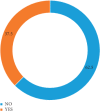Long-Lasting Insecticide-Treated Nets: Assessment of the Awareness and Utilization of Them among Antenatal Clinic Attendees in Abakaliki, Southeast Nigeria
- PMID: 32411254
- PMCID: PMC7210555
- DOI: 10.1155/2020/2984867
Long-Lasting Insecticide-Treated Nets: Assessment of the Awareness and Utilization of Them among Antenatal Clinic Attendees in Abakaliki, Southeast Nigeria
Abstract
Background: The use of long-lasting insecticide-treated nets (LLITNs) is one of the effective strategies for the prevention of malaria, especially among pregnant women.
Aim: This study is aimed at assessing the awareness and utilization of LLITNs during pregnancy among antenatal clinic attendees at the Alex Ekwueme Federal University Teaching Hospital Abakaliki.
Materials and methods: This was a cross-sectional study among antenatal attendees at the Alex Ekwueme Federal University Teaching Hospital Abakaliki, Ebonyi State. A semistructured questionnaire was used to obtain relevant information from the participants. Data analysis was done using SPSS version 20.
Results: The mean age of the women was 26.05 ± 5.76 years. About one-third (30%) of the respondents were nulliparous. Most of the respondents had at least a secondary education. More than ninety percent of the respondents had a good knowledge of malaria with 95.8% being aware of LLITNs. The main source of information was from hospitals (54.5%). The rate of utilization of LLITNs was 37.5%; however, consistent use was only reported by about a third of this proportion. The major reasons for not utilizing the nets include discomfort/heat and fear of the chemical content. Women with tertiary education were more likely to utilize mosquito nets during pregnancy compared with women with secondary or primary education. Women who live in rural areas (OR = 0.393 95% CI 0.602-0.073) were less likely to use LLITNs during pregnancy, while those who are aware of the aetiology of malaria (OR = 4.38 95% CI 0.983-19.591) were more likely to utilize LLITNs in pregnancy.
Conclusion: The level of awareness of LLITNs is high; however, its utilization was discouragingly low. Rural dwellers and those without appropriate knowledge of the aetiology of malaria were less likely to use LLITNs in pregnancy.
Copyright © 2020 Chidebe Christian Anikwe et al.
Conflict of interest statement
The authors declare that they have no conflicts of interest.
Figures
Similar articles
-
Factors affecting the utilization of long lasting insecticide treated bed nets among people living with HIV/AIDS in Bassa Local Government area of Plateau State, Nigeria.Res J Health Sci. 2015 Apr-Jun;3(2):79-90. Res J Health Sci. 2015. PMID: 34109264 Free PMC article.
-
Awareness and utilization of insecticide treated mosquito nets among pregnant mothers at a tertiary health institution in north-western Nigeria.Niger J Med. 2009 Apr-Jun;18(2):175-8. doi: 10.4314/njm.v18i2.45059. Niger J Med. 2009. PMID: 19630324
-
Use of long-lasting insecticidal nets among women attending antenatal clinic at a tertiary hospital in Bayelsa State, Nigeria 2019.Malar J. 2020 Dec 14;19(1):455. doi: 10.1186/s12936-020-03531-y. Malar J. 2020. PMID: 33317541 Free PMC article.
-
Effect of health education on knowledge of malaria and long lasting insecticide-treated nets among clients accessing care in the out-patient Department of a Secondary Health Facility in Plateau State, Nigeria.J Med Trop. 2015 Jul-Dec;17(2):65-70. doi: 10.4103/2276-7096.162283. Epub 2015 Aug 5. J Med Trop. 2015. PMID: 34109137 Free PMC article.
-
Coverage of intermittent preventive treatment and insecticide-treated nets for the control of malaria during pregnancy in sub-Saharan Africa: a synthesis and meta-analysis of national survey data, 2009-11.Lancet Infect Dis. 2013 Dec;13(12):1029-42. doi: 10.1016/S1473-3099(13)70199-3. Epub 2013 Sep 18. Lancet Infect Dis. 2013. PMID: 24054085 Review.
Cited by
-
Prevalence of malaria and associated factors among febrile children under 15 years at Bududa General Hospital, Eastern Uganda.Malar J. 2025 Feb 7;24(1):38. doi: 10.1186/s12936-024-05218-0. Malar J. 2025. PMID: 39920797 Free PMC article.
-
Utilization of long-lasting insecticide-treated net and its associated factors among pregnant women in Dawo district, Southwest Shoa Zone, Oromia, Ethiopia, 2023.Front Public Health. 2024 Jan 29;11:1261254. doi: 10.3389/fpubh.2023.1261254. eCollection 2023. Front Public Health. 2024. PMID: 38348378 Free PMC article.
-
Socio-demographic and economic inequity in the use of insecticide-treated bed nets during pregnancy: a survey-based case study of four sub-Saharan African countries with a high burden of malaria.Arch Public Health. 2023 Apr 21;81(1):64. doi: 10.1186/s13690-023-01075-6. Arch Public Health. 2023. PMID: 37085893 Free PMC article.
References
-
- Ozims S. J., Eberendu I. F. Awareness, ownership, and utilization of long-lasting insecticide-treated nets (LLIN) among pregnant women attending Antenatal clinic in Imo State University Teaching Hospital, Orlu, Imo State. International Journal of Medical Research and Health Sciences. 2014;4(8):14–21.
-
- World Malaria Report 2017. Geneva, Switzerland: World Health Organization; 2017.
-
- World Health Organization (WHO) Malaria. This year’s World malaria report at a glance. November 2018. https://www.who.int/malaria/media/world-malaria-report-2018/en/
-
- Okoye C. A., Isara A. R. Awareness on the use of insecticide-treated nets among women attending Antenatal Clinic in a Tertiary Health facility in South-South Nigeria. Nigerian Medical Practitioner Journal. 2011;52(2):67–70.
LinkOut - more resources
Full Text Sources



